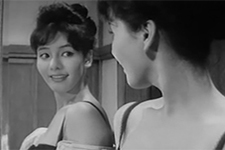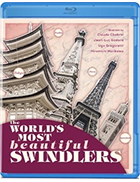The World's Most Beautiful Swindlers (Les plus belles escroqueries du monde)
|  One of the most popular, but rarely remarked upon trends in European art cinema in the 1960s was the omnibus or multi-director film, which assembled short films by a half dozen or so major directors that were usually bound together by some common theme. Omnibus films in general have not typically received much critical or scholarly attention even though they have been consistently popular over the decades. In his book Beyond the Subtitle: Remapping European Art Cinema, Mark Betz compiled a filmography of 474 such films produced between 1930 and 2007 in 72 different countries. Outside of the U.S. in the 1990s, a good chunk of these films were produced in France and Italy in the 1960s, the period when European cinema was internationally “legitimated” as a genuine art form through the various new waves that swept through the major film-producing nations. One of the lesser known omnibus films of that era is The World’s Most Beautiful Swindlers (Les plus belles escroqueries du monde), which was little more than a blip on the radar when it was first released in 1964 (despite the participation of not one, but two major French New Wave directors, James Monaco gives it only brief mention in his groundbreaking study The New Wave). The film was put together by producer Pierre Roustang, who two years earlier had produced the omnibus film Love at Twenty (L’amour à vingt ans, 1962), which featured segments directed by Shintarô Ishihara, Marcel Ophüls, Renzo Rossellini, Andrzej Wajda, and François Truffaut, the latter of whose segment “Antoine et Colette” was a sequel to The 400 Blows (1959). Roustang recreated that cross-continental mix of talent in The World’s Most Beautiful Swindlers by bringing together a Japanese director (Hiromichi Horikawa), a Polish director (Roman Polanski), an Italian director (Ugo Gregorett), and two French directors (Claude Chabrol, and Jean-Luc Godard). As the title The World’s Most Beautiful Swindlers would suggest, all of the segments (or “sketches”) are connected by the theme of duplicity, with each story centering around a swindler or con artist taking advantage of someone (sometimes successfully, sometimes not). The film’s self-referential internationalism is emphasized via each segment being set in different far-flung city—Tokyo, Amsterdam, Naples, Paris, and Marrakesh—which allows it to function, particularly for American viewers, as a kind of exotic travelogue. The film’s exact structure has varied over the years, as viewers who saw it when it was belatedly released in U.S. theaters in 1967 did not see Godard’s contribution, which was cut from those prints. Since the film has been restored, Godard’s segment has been reinstated, but now Polanski’s segment has now been removed, this time at the request of the director (this is the version of the film I saw, so I cannot comment on Polanski’s Holland-set story, nor have I been able to determine why exactly he wanted it removed). Like most omnibus films, the quality of The World’s Most Beautiful Swindlers varies from sketch to sketch, with some working quite well while others feel a bit thin. Arguably the best sketch in the film is Godard’s, although it is also the least plot-driven, which is most likely why it was cut from U.S. prints (once again demonstrating how many American distributors did not understand European art cinema). Unlike the other stories in the film, which follow fairly conventional plots involving people trying to con each other, Godard’s segment is more discursive and philosophical in interrogating the nature of reality by verbally pitting a San Francisco-based photographer (Jean Seberg) against a Moroccan counterfeiter (Charles Denner), who points out to her that she is also in the business of fakery due to the deceitful nature of her camera. Godard’s sketch, which concludes the film, couldn’t be more different from Hiromichi Horikawa’s opening Japanese segment, which finds an ambitious geisha (Mie Hama) trying to make off with a wealthy miser’s platinum false teeth after he chokes to death on some noodles. Hama, who would go on to international fame playing an early “Bond girl” in You Only Live Twice (1967), is lively but facile, and the segment strains for humor (Horikawa had worked as an assistant director for Akira Kurosawa in the late 1950s, but he doesn’t display much sensitivity or tact here). Much better is Ugo Gregoretti’s Naples-set story about a prostitute who hatches a scheme to marry an older, retired man in order to secure citizenship and Chabrol’s Paris-set story about a team of con artists who trick a naïve tourist (a German Francophile played by Francis Blanche) into thinking he has bought the Eiffel Tower. Gregoretti was probably the least-well known filmmaker in the bunch, having directed a handful of documentaries and a few feature films at the time, although he had contributed to the omnibus film Ro.Go.Pa.G. (1963), whose roster of directors also included Godard, Pier Paolo Pasolini, and Roberto Rossellini. Chabrol, of course, was one of the pioneering members of the French New Wave, and while his sketch here doesn’t stand up to his best work, it is still an amusing satire built on a fundamentally outrageous scenario that he still manages to make amusingly plausible.
Copyright © 2017 James Kendrick Thoughts? E-mail James Kendrick All images copyright © Olive Films | |||||||||||||||||||||||||||||||
Overall Rating: 

 (2.5)
(2.5)


